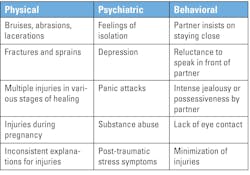Managing workplace violence in the laboratory
As laboratory safety professionals, we often focus on chemical hygiene, biohazard safety, waste handling, and emergency management. However, there is another critical aspect of laboratory safety that is demanding our attention more and more: workplace violence. Unfortunately, this topic has historically been overlooked in lab safety discussions, but it is time to change that.
Workplace violence (WPV) encompasses a wide range of aggressive behaviors. The National Institute of Occupational Safety & Health (NIOSH) defines WPV as "any violent act, including physical assaults and threats of assault, directed toward team members at work or on duty and include physical injury, threats, abuse, hostility, harassment, discriminatory language/behavior and other forms of verbal violence that can potentially escalate to physical violence."
It is crucial to understand that physical injury is not a prerequisite for an incident to be classified as workplace violence. Assault, in this context, includes any act that puts another person in reasonable apprehension of imminent harmful or offensive contact. For those that work directly with patients, this can be difficult to understand since, historically, some violent behaviors by patients have been tolerated by employees and treated as just part of the job.
Recognizing workplace violence
There are four main types of workplace violence, listed from the least to most common in healthcare settings: criminal intent, worker on worker, personal relationship, and customer/client (client on worker).
Criminal intent typically involves crimes like robbery or trespassing. Worker-on-worker violence often stems from breakdowns in relationships, sometimes between colleagues. Personal relationship violence, often related to domestic issues, involves a perpetrator with a personal connection to a laboratory employee. Customer/client violence, the most common in healthcare, occurs when a client becomes violent toward an employee or group of employees. This often occurs when there are disputes over service, products, or money.
Early recognition of potential violence is key to prevention. There are several signs of aggression that can be identified when employees keep watch for them. Disruptive behavior towards team members, patients, or visitors may occur. Co-workers or customers might be irritable and easily provoked to anger. Verbal outbursts with an intent to intimidate or threaten are signs of potential violence. The use of foul language, insults, or clear threats of violence should always be addressed in the workplace. Sexually inappropriate or discriminatory language should be recognized and escalated to leadership properly. Physical actions like slamming doors, throwing objects, or kicking furniture as well as threatening gestures, attempts to strike people, or grabbing clothes should all be addressed early as workplace violence.
Domestic violence is something that can spill over into the workplace as well, affecting both patients and co-workers. It is characterized by a pattern of coercive behaviors, including physical, emotional, and sexual abuse, as well as social isolation and intimidation (see Table 1 for Indicators of Domestic Violence).
De-escalating workplace violence
Before violence is recognized in the laboratory, it is important to train laboratory staff in de-escalation techniques. De-escalation is a crucial skill in managing potential violence, and there are helpful and effective strategies to put into practice. Teaching staff when to pick a battle can be key. Determine if the issue at hand is mandatory or negotiable. Offering flexibility when possible can be a powerful de-escalation tool.
If someone exhibits violence and seems to be in crisis, they may not comply simply because someone else is insisting they do. Empowering someone to make their own choice is often more effective than overpowering them. When a situation arises, make sure staff do not hesitate to involve department leaders, security personnel, or risk managers when needed. A fast escalation can help to bring resolution to a violent situation very quickly.
Train staff to always maintain calm body language. Keep hands open and visible, maintain non-threatening eye contact, and avoid finger-pointing or crossing of arms. Active listening is also a valuable skill in such situations. Demonstrating empathy and acknowledging concerns can go a long way in diffusing tense situations. Lastly, ensure staff remembers to respect personal space in potentially violent situations. Always maintain an arm's length distance and avoid touching the agitated person.
Good communication skills are vital when dealing with someone who may be upset. Ninety percent of human communication is non-verbal. Staff need to pay attention to their tone, volume, posture, and facial expressions. These can significantly impact how the de-escalating message is received.
Workplace violence response measures
Despite our best prevention efforts, violent situations may still occur in the laboratory setting. While having a visible security presence in the workplace can decrease the probability of active violence, every laboratory should have a comprehensive workplace violence response plan. This plan should outline clear procedures for various scenarios and be regularly reviewed and practiced by all staff members.
Some violent situations may involve an active shooter. The Federal Bureau of Investigations (FBI) recommends the Run-Hide-Fight strategy for any active shooter situations.
Run: Have an escape route planned. Leave personal belongings behind and evacuate regardless of whether others follow. Help others escape if possible, but do not move the wounded. Prevent others from entering the area where the shooter may be.
Hide: If you cannot run, hide in an area out of the shooter's view. Lock the door or block the entry. Silence your cell phone (including vibrate mode) and remain quiet.
Fight: As a last resort, when your life is in imminent danger, fight with as much physical aggression as possible. Improvise weapons and commit fully to your actions.
If law enforcement arrives during an active violence situation, it is important to train team members how to act. They should remain calm and follow all the instructions given by the authorities. Staff should drop any items held in their hands. They should raise their hands and spread their fingers and keep their hands visible at all times while moving as directed.
Workplace violence and lab safety
Preventing workplace violence is about more than just responding to incidents — it is about creating a culture of safety and respect for employees and customers. Leaders should conduct regular training and competency sessions on recognizing potential threats, de-escalation techniques, and proper response procedures. Leaders should also foster an environment where laboratory employees feel comfortable reporting concerns without fear of retaliation.
Regularly assess the laboratory for potential security vulnerabilities and address them promptly. Establish support systems for employees who may be experiencing domestic violence or other personal issues that could potentially lead to workplace violence. Implement and strictly enforce a zero-tolerance policy for workplace violence, including verbal abuse and threatening behavior.
In addition, laboratory leaders should establish strategies to identify and address the factors that contribute to violence throughout the workplace/organization. The organization needs to maintain a process to ensure the prompt and accurate reporting of all incidents of violence, including those with no physical injury. All leaders and staff should be empowered with the necessary tools to eliminate violence in their areas, and leadership accountability should be cultivated to reduce violence.
Workplace violence is a serious issue that demands our attention and action. It is a safety topic that should be addressed in the laboratory and in every workplace. By understanding the types and signs of workplace violence, mastering de-escalation techniques, and implementing comprehensive response plans, we can create safer laboratory environments for everyone.
Remember, safety is everyone's responsibility. Remain vigilant, communicate openly, and always prioritize the well-being of yourself and your colleagues. With the right knowledge and preparation, we can effectively manage and prevent workplace violence in our laboratories.
About the Author

Dan Scungio, MLS(ASCP), SLS, CQA (ASQ)
has more than 25 years of experience as a certified medical tech. He was a lab manager for 10 years before becoming the laboratory safety officer for Sentara Healthcare, a system of 12 hospitals and more than 20 labs and draw sites in Virginia and North Caroline. As “Dan the Lab Safety Man,” he provides consulting, education, and training in the U.S. and Canada.

